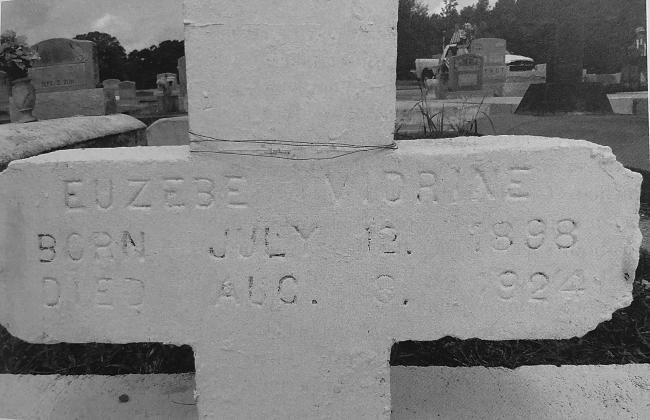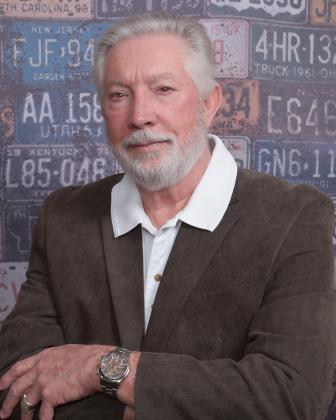Many Cajun men, and sometimes women, gather at suppers around a black pot sharing stories of how big a fish they caught in the bayou or how many squirrels they killed on opening weekend. Other times, stories are shared of events which happened back in time, or as said in the local colloquialism “dans temps.”
Rayne native William Thibodeaux decided to record these stories in his new book Historic Tales of Acadiana. One of the stories in the book takes place near an area of Evangeline Parish named after black pot... L’Anse de Chaudiere.
The isolated community is in the extreme southeastern part of the parish near the St. Landry Parish line. It is near where former St. Landry Sheriff Marion Swords was gunned down and killed on July 17, 1916.
As Thibodeaux explained, Sheriff Swords was originally from Pointe Coupee Parish, and his parents were from Mississippi and Georgia. He adamantly opposed the creation of Evangeline Parish because, as Thibodeaux said, “it was cutting out some of his territory.”
The events that transpired near L’Anse de Chaudiere began when Helaire Carriere, a convicted murdered, escaped from jail in Jennings. While on the run, he hid out in the area of the Mallet Woods.
Two black men, Paul Durousseau and Bruno St. Andre, reported to Sheriff Swords they had seen Carriere and he was staying at the home of Ella Fontenot and her mother.
“The sheriff took the two black men with him so they could show him exactly where it was,” Thibiodeaux said. “And he brought his chief deputy. He should have brought more people than that. He figured they were on friendly terms and Helaire wouldn’t present a problem.”
Thibodeaux, in his book, recounts the events which followed which resulted in the sheriff’s shooting. “The bullet entered the sheriff’s body just above the heart,” according to the book. “The coroner later testified that the bullet, after striking Swords, traveled in a downward path, piercing the sheriff’s heart and causing instant death.”
Carriere is not the only convicted murderer in Thibodeaux’s book. There is also a chapter on Euzebe Vidrine- the last man hanged in Evangeline Parish on August 8, 1924.
Vidrine was a serial killer before the term was coined. The last person he killed was Leo Wiggins Jr., the son of Evangeline Parish Sheriff Leo Wiggins.
As many times before, Vidrine took an item off of the younger Wiggins’ body. “That’s what led to his demise,” said Thibodeaux. “Euzebe, like all serial killers, collected something. Euzebe was a collector of watches mostly, and that was his downfall.”
He went on to say, “I actually met a nephew of the old sheriff, who had the same name, at the museum in Gueydan several years back. He told me he actually has the watch Euzebe had taken from the body. The poor fella died three or four years ago. After he died, I made a comment on the electronic obit that I just hoped the family knows the significance of the watch and the history behind it. I got a response saying they knew that was the watch that Euzebe had stolen.”
At trial, Vidrine was represented by Ville Platte attorneys J. Hugo Dore and J. Cleveland Fruge. On the bench was Judge B. H. Pavy, who plays a role in another chapter of Thibodeaux’s book.
Vidrine was ultimately convicted and sentenced to death. As Thibodeaux said, though, “People say the state actually hanged a dead man. Euzebe always said he would not hang from the end of a rope.”
Thibodeaux continued, “The night before, he had a razor blade that he cut his throat with. A lot of people say they hanged a dead man because they had to carry him up there.”
Getting back to Judge Pavy, Thibodeaux dedicates a chapter in his book to the judge’s connection in the alleged conspiracy to kill Huey Long. Until the mid-1930s, Evangeline Parish was still in the 16th Judicial District Court with St. Landry Parish.
According to Thibodeaux, Long and Judge Pavy were archenemies. Long pushed through a gerrymandering of districts to weaken the judge’s power.
As said in the book, “(Senator Long) persuaded the legislature to realign the voting district ... with a generous helping of pro-Long supporters. The realignment, or gerrymandering, effectively forced Judge Pavy not to run for the judgeship. The judge and his family did not take too kindly to this.”
One member of the family, Dr. Carl Weiss, especially took exception to the gerrymandering to the point, according to tradition, that he shot and killed Senator Long in the state capitol on September 8, 1935.
However, as Thibodeaux claims in his book, Weiss was the fall guy for the assassination. “A lot of people say there was a conspiracy to kill Huey Long,” he said. “I quote several different newspapers. At the time, they said Weiss drew the short straw. He was supposed to kill Huey Long, but some people believe it was one of his officers.”
After being shot, Senator Long was taken to Our Lady of the Lake Hospital where he was operated on by Dr. Arthur Vidrine of Ville Platte and Dr. E.L. Sanderson of Shreveport.
Other stories in Thibodeaux’s book revolve around the creation of Acadia Parish and the Cajun Music Hall of Fame and Museum as well as other tales across the Cajun Prairie.
As for Thibodeaux, he joined the U.S. Navy in 1967 at the age of 18 and served on the U.S.S. O’Bannon in the West Pacific. After his military service was completed, he went to work for the Southern Pacific Railroad as a track laborer. He stayed working for the railroad in different capacities for 44 years until his retirement.
“One thing about retirement is you have to have something to do,” Thibodeaux said. “If you don’t, you’ll be in bad shape. I enrolled in a life writing class at UL, and I did that for a while. Every weekend I submitted a little story, and a lot of people liked the stories. They asked me why I didn’t submit those stories to the newspapers because a lot of them did that.”
Thibodeaux then began having his stories printed in several local newspapers. “A lot of people then asked me to put a book together,” he remarked. “I finally decided I’d do it. I published my first book in 2019.”
The stories in Thibiodeaux’s books come from his own personal research. “Most of it comes from old newspaper articles,” he said. “I used to spend a lot of time at Dupre Library. After I retired from the railroad, I spent a lot of time at the library going through the archives one page after another reading the old stories.”
“When I found something of interest,” he continued, “I would make copies of it and bring it home. Fortunately, nowadays, you can get access to a lot of the old newspapers online and you don’t have to leave your house. You can be in your pajamas and do all that.”
Collecting these stories in book form is important for Thibodeaux because it is a way to preserve the past.
“These stories are old stories from a long time ago,” he expressed. “If you don’t bring them up again, these stories would probably be buried forever until somebody goes into the archives and starts pulling them up.”
He concluded, “It’s history. I just hate to see all of our history disappear without anyone knowing anything about it. In our state, we are rich in history.”
Rayne native collects stories of region’s rich history
Image
Tony Marks
Editor



